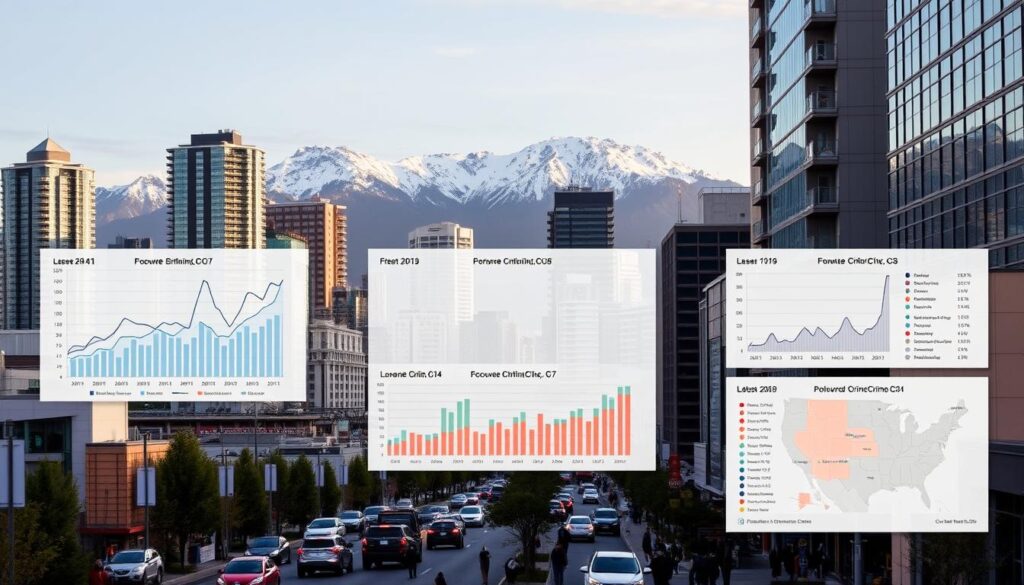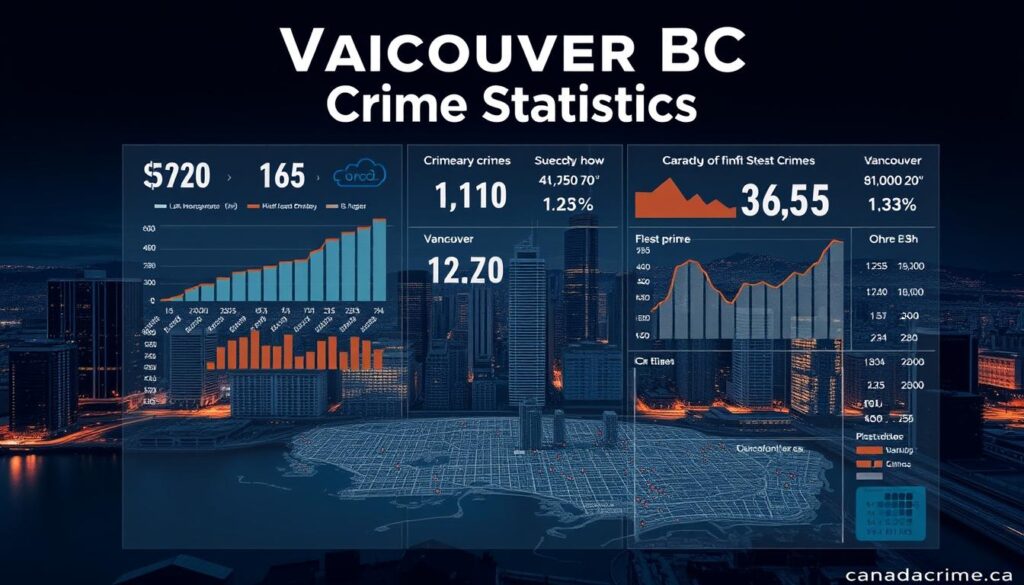Crime statistics are a crucial tool for law enforcement agencies, providing insights into trends and patterns of criminal activity. According to the Vancouver Police Department, these statistics help identify areas of concern, allocate resources effectively, and measure the success of crime prevention initiatives.
The timely release of crime data is essential, although official statistics can be delayed by two to three months due to rigorous quality control processes. This comprehensive analysis will delve into the current state of crime in Vancouver, examining both violent and property crime trends across different neighborhoods.
By exploring the methodologies used by the Vancouver Police Department and Statistics Canada, we can gain a deeper understanding of the crime rate and its implications for public safety.
Current State of Crime in Vancouver BC
Vancouver BC has seen a significant shift in its crime landscape over the past few years, with recent data offering insights into the current state of criminal activity. According to the Vancouver Police Department, crime continues to fall in the city, with notable decreases in property crime, assaults, and stolen vehicles over the first six months of 2024 compared to the same period in 2023.
Overview of Recent Crime Trends
Recent Vancouver BC crime statistics reveal a significant downward trend in overall criminal activity during the first half of 2024. Property crimes have shown notable decreases, with break-and-enters to homes and businesses down by approximately 30%, and vehicle thefts reduced by nearly 20%. The data indicates that break-and-enters dropped from 1,604 to 1,125, theft of motor vehicles decreased from 417 to 335, and break-ins to vehicles fell from 3,490 to 3,041. Additionally, assaults decreased from 2,371 to 2,209, contributing to the overall decline in crime.

Comparison to Pre-Pandemic Levels
While violent crime in Vancouver fell by seven percent in the first half of 2024 compared to 2023, it remains above pre-pandemic levels. The geographical distribution of crime reduction is uneven, with areas west of Cambie Street experiencing the largest decline in violent crimes at 22.8%. A comparison to pre-pandemic levels shows that violent crime in 2023 was 8.6 per 100,000 people, up from a pre-pandemic low of 7.8, but still significantly lower than the 13 violent crimes per 100,000 residents recorded in 2006.
| Crime Category | 2023 | 2024 | Change |
|---|---|---|---|
| Break-and-enters | 1,604 | 1,125 | -30% |
| Theft of Motor Vehicles | 417 | 335 | -20% |
| Assaults | 2,371 | 2,209 | -7% |
For more information on crime rates across Canada, you can explore Canada’s crime rates.
Vancouver BC Crime Statistics: A Comprehensive Analysis
A comprehensive analysis of Vancouver’s crime statistics reveals the city’s complex criminal landscape. This analysis is crucial for understanding the trends and patterns in criminal activity, providing insights that can inform both policy and public perception.
Violent Crime Rates and Patterns
Violent crime in Vancouver has shown a mixed trend. In the first half of this year, there was a 7% decrease in violent crimes compared to the same period in 2023, with 2,837 violent crimes reported versus 3,051 in the previous year. However, when compared to pre-pandemic levels in 2019, the current figures remain approximately 7% higher, with 2,654 violent crimes reported in the first half of that year. Violent crime includes a range of offenses such as homicide, attempted murder, assaults, robbery, and sexual offenses.
- The data indicates a fluctuating trend in violent crime rates, with a recent decrease but still elevated levels compared to pre-pandemic times.
- The Vancouver Police Department attributes these changes to factors including enhanced police presence and improved response to non-emergency calls.

Property Crime Statistics
Property crime statistics in Vancouver show significant improvements over the years. Notably, break-ins to vehicles have seen a dramatic long-term reduction, dropping from 16,488 in 2019 to 7,171 in 2023. This represents a substantial decrease in property crime, contributing to a safer environment for residents and visitors alike.
- The reduction in property crime is attributed to multiple factors, including enhanced policing strategies and community initiatives.
- The Vancouver Police Department’s focus on addressing repeat offenders has also played a crucial role in this decline.
Geographical Distribution of Crime in Vancouver
The geographical distribution of crime in Vancouver reveals a complex pattern, with significant disparities between neighborhoods. While overall crime rates have seen a decline, certain areas continue to experience higher levels of criminal activity.

Downtown Vancouver Crime Patterns
Downtown Vancouver, covered by police district D1, has seen a slight year-over-year increase of 2.5% in violent incidents. This trend is notable as most other districts experienced decreases in violent crime. The downtown area’s crime pattern is distinct, with a mix of property and violent crimes.
Key Statistics:
- Violent crimes in D1 increased by 2.5%.
- Assaults and robberies are among the most common violent crimes.
Neighborhood-by-Neighborhood Breakdown
A closer examination of Vancouver’s neighborhoods reveals stark contrasts in crime rates. For instance, Strathcona recorded 52 assaults and 11 robberies in June, significantly higher than more affluent areas like Dunbar-Southlands and West Point Grey, which reported only 4 and 3 assaults, respectively.
| Neighborhood | Assaults (June) | Robberies (June) |
|---|---|---|
| Strathcona | 52 | 11 |
| Dunbar-Southlands | 4 | 0 |
| West Point Grey | 3 | 0 |
| Killarney | N/A | 0 |
The Vancouver Police Department uses these geographical crime patterns to allocate resources effectively and implement targeted crime prevention initiatives in high-risk communities.
Understanding Canada’s Crime Code
Canada’s Crime Code is the backbone of the country’s legal framework for addressing and prosecuting criminal offenses.
The Crime Code provides a comprehensive system for classifying criminal offenses, which is crucial for understanding crime statistics and trends in Canada, including in Vancouver BC. The code categorizes offenses based on their severity and type, directly influencing how crime data is collected, reported, and analyzed.
Structure and Classification of Criminal Offenses
The Crime Code establishes a hierarchical structure for criminal offenses, ranging from summary offenses to serious indictable offenses. This structure is vital for law enforcement agencies, such as the Vancouver Police Department (VPD), to report crime statistics using the “most serious offence method.” In contrast, other agencies might use the “all violations method,” highlighting the importance of understanding these differences when comparing crime statistics.
The classification system also impacts how Statistics Canada categorizes and reports crime data, which can sometimes lead to variations in crime rates due to differences in reporting methodologies.

Recent Changes to the Criminal Code
Recent amendments to the Criminal Code have focused on emerging crime patterns, including cybercrime, hate crimes, and offenses related to substance use. These changes reflect the evolving nature of crime and the need for the legal system to adapt accordingly.
Furthermore, Statistics Canada periodically updates offence codes, which can affect year-to-year comparisons of crime statistics. This necessitates careful analysis when examining long-term crime trends.
- The Crime Code provides the legal framework for prosecuting criminal offenses across Canada.
- Understanding the distinction between different crime reporting methods is crucial for interpreting crime rate data accurately.
- Recent changes to the Criminal Code address emerging crime patterns and update laws to reflect current societal needs.
Crime Reporting Methods in Canada
Effective crime reporting is essential for understanding crime trends and patterns in Canada. The methods used to collect and analyze crime data can significantly impact the insights gained from crime statistics.
VPD’s Reporting System vs. Statistics Canada
The Vancouver Police Department (VPD) and Statistics Canada employ different methodologies for reporting crime data. The VPD uses the Police Records Information Management Environment (PRIME) system, which allows for dynamic updates as investigations progress and offenses are reclassified. In contrast, Statistics Canada uses the Uniform Crime Reporting (UCR) survey, which counts only the Most Serious Offence (MSO) in each incident.
- The VPD’s GeoDASH system counts every offense in an incident, resulting in higher reported crime numbers.
- Statistics Canada’s UCR survey provides a standardized national framework for crime statistics.
For more information on crime rates, you can explore Canada’s violent crime rate in 2024.
How Crime Data is Collected and Analyzed
Crime data collection and analysis involve multiple systems that gather, analyze, and disseminate crime information. The VPD’s PRIME system tracks incidents and allows for updates as investigations evolve. Crime data is crucial for understanding trends and patterns, and it is used by law enforcement agencies to inform their strategies.

The differences in reporting methodologies between the VPD and Statistics Canada highlight the need for careful interpretation of crime data. By understanding these differences, stakeholders can better analyze crime trends and develop effective crime prevention strategies.
Vulnerable Populations and Crime Victimization
Vulnerable populations in Vancouver, BC, face disproportionate impacts from crime, highlighting the need for targeted support and intervention strategies. The victimization patterns among different demographic groups reveal significant disparities, with certain populations being more affected than others.

Indigenous Victims and Overrepresentation
Indigenous girls and women are consistently overrepresented as victims of violence according to Vancouver Police Department data. This overrepresentation highlights a critical area for intervention and support, necessitating a deeper understanding of the underlying causes and the development of culturally sensitive support services.
- Crime victimization patterns show that Indigenous populations are disproportionately affected.
- The relationship between socioeconomic factors and crime victimization indicates that marginalized communities face higher rates of both property and violent crime.
Other Vulnerable Demographics
Other vulnerable demographics, including those with mental health challenges and substance use disorders, are also at a higher risk of becoming both victims and perpetrators of crime, creating complex cases that require specialized approaches. Understanding these patterns is essential for developing targeted crime prevention strategies and support services that address the specific needs of vulnerable people within Vancouver’s diverse communities.
By examining the specific challenges faced by these groups, law enforcement and social services can work together to create more effective support systems, ultimately reducing the incidence of crime and improving the safety and well-being of all people in Vancouver.
Historical Context: Vancouver Crime Over the Decades
Vancouver’s crime landscape has undergone significant transformations over the decades. Understanding these changes provides valuable insights into the current state of crime in the city.
Long-Term Crime Trends Since 2000
Since the early 2000s, Vancouver has seen notable fluctuations in its crime rates. The violent crime rate peaked in 2006, with 13 violent crimes per 100,000 residents, marking the highest level in recent decades. Following this peak, there was a steady decline, reaching a pre-pandemic low of 7.8 violent crimes per 100,000 people. Although the rate slightly increased to 8.6 in 2023, it remains substantially lower than the historical highs. The total number of crimes reported to the Vancouver police also decreased significantly, from 56,807 in 2019 to 46,259 in 2023, a reduction of over 10,500 crimes in just five years.

Impact of Major Events on Crime Rates
Major events have significantly impacted crime patterns in Vancouver. The 2010 Winter Olympics and the COVID-19 pandemic are notable examples. The pandemic, in particular, affected the types of crimes committed as city dynamics shifted during lockdown periods. Analyzing these events helps in understanding the crime trends and how they are influenced by broader societal factors.
The analysis of Vancouver police statistics over the years highlights the dynamic nature of crime in the city. By examining these trends, law enforcement and policymakers can develop more effective strategies to address crime and improve public safety.
Factors Influencing Crime Rates in Vancouver
Multiple factors contribute to the crime rate in Vancouver, necessitating a comprehensive approach to understand and tackle the problem. The city’s crime landscape is complex, influenced by various socioeconomic, environmental, and law enforcement factors.
Socioeconomic Factors
Socioeconomic conditions play a significant role in shaping crime trends in Vancouver. Areas experiencing higher poverty, unemployment, and housing instability often show elevated incidents of both property and violent crime. Addressing these underlying issues is crucial for reducing crime rates.
Pandemic Effects on Criminal Activity
The COVID-19 pandemic dramatically altered criminal activity patterns in Vancouver. Initially, certain crimes decreased due to lockdowns, but new challenges related to public disorder and mental health crises emerged as the pandemic progressed. This shift highlights the need for adaptive law enforcement strategies.
Law Enforcement Strategies
Vancouver Police Chief Adam Palmer credited the addition of new police officers and mental health workers for the recent downward trend in crime rates. Effective law enforcement strategies, combined with community engagement, are vital for maintaining public safety and addressing concern among residents.

The interplay of these factors underscores the complexity of managing crime in Vancouver. By understanding and addressing these elements, the city can work towards creating a safer environment for its people.
Preventing Crime in Vancouver and Canada
To effectively prevent crime in Vancouver and Canada, it’s essential to understand the root causes and implement targeted interventions. Crime prevention is a complex issue that requires a multifaceted approach, involving government agencies, law enforcement, and community organizations working together to address the underlying factors that contribute to criminal activity.
Community-Based Prevention Initiatives
Community-based prevention initiatives play a crucial role in reducing crime rates in Vancouver and across Canada. These initiatives focus on neighborhood engagement, youth programs, and creating supportive environments that reduce the likelihood of criminal activity before it occurs. Some examples include:
- Youth mentorship programs that provide guidance and support to at-risk youth
- Community policing initiatives that foster trust and cooperation between law enforcement and local residents
- Neighborhood clean-up and beautification projects that help to reduce crime and improve quality of life
By engaging with local communities and addressing the root causes of crime, these initiatives can help to prevent criminal activity and promote safer communities.
Government and Police Prevention Programs
In addition to community-based initiatives, government and police prevention programs are also critical in preventing crime in Vancouver and Canada. The Vancouver Police Department has developed specialized units and programs targeting high-risk times and locations, with particular attention to repeat offenders who account for a disproportionate number of property crime incidents. Government prevention programs include recent pledges by provincial leaders to implement involuntary care for people with severe mental health or substance-use disorders, recognizing the connection between these issues and public safety concerns.
For instance, Premier David Eby has emphasized that ensuring residents feel safe in their downtown communities is “critical,” highlighting the importance of both reducing actual crime rates and addressing public perceptions of safety. By working together, government agencies, law enforcement, and community organizations can develop effective strategies to prevent crime and promote a safer environment for everyone.
Some key government and police prevention programs include:
- Specialized police units targeting high-risk areas and repeat offenders
- Programs addressing mental health and substance-use disorders
- Community-based initiatives promoting public safety and crime prevention
Public Perception vs. Statistical Reality
The public’s perception of crime in Vancouver often diverges from the statistical reality, posing challenges for both policymakers and law enforcement agencies. This discrepancy is not unique to Vancouver but is particularly pronounced in the city’s downtown areas, where visible street disorder and homelessness can create impressions of danger that may not align with actual violent crime rates.
Media Coverage and Public Fear
Media coverage tends to highlight violent crimes and random assaults, which can amplify public fear despite data from the Vancouver Police Department showing a steady decline in unprovoked stranger assaults over recent years. For instance, a report to the police board in November 2023 noted that a random sample of assault data from 2021, 2022, and 2023 “suggests a steady decline in unprovoked stranger assaults.” This indicates that while certain crimes receive significant media attention, the overall trend may be more positive than perceived.
“A random sample of assault data from 2021, 2022, and 2023 ‘suggests a steady decline in unprovoked stranger assaults.'” – Vancouver Police Department Report, November 2023
Addressing Misconceptions About Crime
The Vancouver Police Department’s GeoDASH system is a step towards addressing misconceptions by providing transparent, neighborhood-level crime data. This allows residents to understand actual crime patterns in their communities, potentially bridging the gap between perception and reality. However, it’s also crucial to address legitimate community concerns about quality of life issues that contribute to feelings of insecurity.
| Crime Type | 2021 | 2022 | 2023 |
|---|---|---|---|
| Violent Crime | 540 | 520 | 500 |
| Property Crime | 1200 | 1150 | 1100 |
Bridging the gap between public perception and statistical reality requires both improved communication about crime statistics and efforts to address community concerns. By leveraging tools like the GeoDASH system and fostering a more informed public discourse, it’s possible to create a more accurate understanding of crime in Vancouver.

Conclusion: The Future of Crime Prevention and Management in Vancouver
The city of Vancouver is witnessing a shift in crime patterns, necessitating adaptive crime prevention strategies. Recent crime data shows a decrease in various types of crimes reported, including break-and-enters, theft of motor vehicles, and break-ins to vehicles. For instance, comparing the January-to-June data to the same period in 2023, break-and-enters dropped from 1,604 to 1,125, and assaults decreased from 2,371 to 2,209.
The Vancouver Police Department, in collaboration with Statistics Canada, plays a crucial role in maintaining accurate crime statistics. The future of crime prevention and management will require innovative approaches that balance data-driven policing with compassionate community engagement. Addressing the overrepresentation of Indigenous people as victims of violence remains a priority.
As crime rates continue to evolve, technology will play an increasingly important role in both crime prevention and reporting. Public education about actual crime rates versus perception will be crucial for building community trust. By understanding Vancouver BC crime statistics within the broader context of Canada crime information, we can inform both policy decisions and individual safety strategies.

